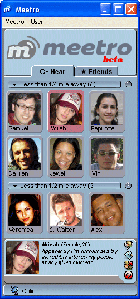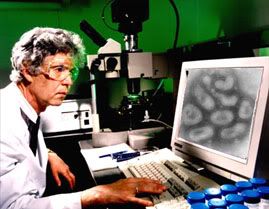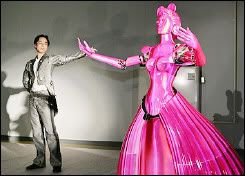
you pee in them, but they're flowers.
read, see more at clarkmade.com
idea via tacky times
Tuesday, June 21, 2005
eau de toilette - clark sorensen's flower shaped urinals
Posted by
Jim
at
3:30 AM
2
comments
![]()
nanochemotherapy

Researchers at the University of Michigan have developed a way to smuggle strong anti-cancer medicine into the center of cancer cells, leaving healthy cells unphased. For the experiment, the researchers used mice which had been engineered with human epithelial cell tumors on their backs, and injected a special concoction of the anti-cancer drug methotrexate, folic acid, and a fluorescent imaging agent all wrapped up within a specially designed nano-particle called a dendrimer.
"The technique employs cunning Trojan horse trickery. All living cells require folic acid to replicate, but cancer cells have a particularly strong appetite for it, displaying up to one thousand more docking sites - called folate receptors - on their membranes. By attaching five folic acid molecules to branches of the dendrimer, the researchers were able to lure the cancer cells into accepting the whole package across the membrane and into the cell - including the toxic drug, which then kills off the cell."
While traditional chemotherapy applies high concentrations of anti-cancer medicine to the affected areas, it also damages living cells in the surrounding tissue. This new technique is the first developed that allows the normally toxic medicine to actively seek out cancer cells, while leaving healthy cells unphased. The medicine, while not curing cancer completely, may one day dethrone cancer as a killer, transforming it instead into a chronic, treatable disease.
In the longest trial of the medicine, ranging over 99 days, 30-40% of the mice given the nano-particle methotrexate survived, while all of those receiving free methotrexate died, either from the toxic effects of the drug or from the cancer itself. In the mice trials, the researchers were effectively able to reach a 30-day delay in tumor growth, which is equivalent to about 3 full years for a person.
The group is hoping to begin drug trials in humans within 18 months, although producing the nano-drug will be a costly and technically difficult process.
source article at newscientist
Posted by
Jim
at
2:11 AM
0
comments
![]()
hackers plunder millions of credit cards

A rogue computer program installed by hackers has been discovered in the database of Cardsystems Solutions, a payment processing firm based in Arizona. The firm has admitted to backing up thousands of transactions - against proper procedure - which eventually led to an orchard of easy pickings for hackers. On Friday, June 17th, Mastercard issued a statement warning that 13.9 million of its customers are "among those affected." While it seems fairly clear that tens of thousands of cards were likely stolen, it is possible that details from up to 40 million cards may have been looted in all. The precise details remain nebulous, like computer information in general, though in-depth investigations are under way.
source article at newscientist
Posted by
Jim
at
1:46 AM
0
comments
![]()
Saturday, June 11, 2005
fevolution: the art of eric feng

Just look at the cool things I find you.

"Fevolution is about infinite evolutionary possibilities."

"Fevolution is about infinite evolutionary possibilities." It's like this web page - life and technology fused together. What would a technological world look like if it were less polluting, less separating, more connecting, allowing people to be something they never were before? This is something I've been thinking about a lot lately, though I'm not sure I've found the answers. It seems the internet has something to do with it, connecting us and helping information evolve. Operating a blog makes you realize the tremendous amount of information and art on the web, that the potential of technology is to create something like a blog community, where you have thousands of independents always digging through vast streams of information to provide in a readable form the most interesting findings for people to read freely. Constantly creating, the internet provides both a capitalist media, but at the same time the opportunity for the spectators to acquire a voice and bring a civilization to evolve through new stages of interconnectivity and access to the performance of information, creating a counter-media in a way that wasn't possible before. Eric Feng's art reminds us of this other side of technology, that a technological world isn't all bleak.
Unfortunately, my thumbnails can't link to the bigger images on Feng's site since it's all flash or something, without individual page addresses. So please visit the site, feric.com, and navigate the simple layout to explore his world of images.
idea via drawn!
Posted by
Jim
at
5:38 PM
0
comments
![]()
knockoff damien hirst replica on ebay for $80,000

Last spring artist Damien Hirst sold a 14 foot tiger shark in a tank of fermaldehyde to a NYC buyer for a whopping total of $8 million. Gersh Kuntzman of Radar magazine, in response to how ridiculously easy it is to make $8 million decided to try his hand in the dead art business, buying a 10-gallon fishtank, as much fermaldehyde, and "a scaly lump of flesh so ugly, so misshapen, that it just might pass for art" - the lumpfish. Since he figured his creation is about 1/100th the size of Hirst's The Physical Impossibility of Death in the Mind of Someone Living he tried to EBay it off for a cool $80,000. Despite the stunning success of other auctions of total shit on EBay, Kuntzman's Hirst replica, unfortunately, failed to receive any bids.
ebay auction here
read the full, hilarious article about Kuntzman's expoits at the new and improved Radar magazine.
Posted by
Jim
at
5:10 PM
0
comments
![]()
Thursday, June 09, 2005
oxytocin - new hormone increases trust and risktaking

Scientists at the University of Zurich have discovered a human hormone that is involved in the process of trust between people. Researchers showed that people who had inhaled the hormone Oxytocin were more likely to trust other people with their money and make business deals. Exhibited in an experiment in which research subjects were given real money before being placed in investment situations with other people, 13 out of 29 Oxytocin subjects handed over all of their money, while only 6 of the 29 given placebos exhibited the same behavior. This means that if people somehow inhaled this cheap and readily available chemical they would be over twice as likely to do business with other people.
Oxytocin is a hormone that is usually released when people are having sex, and also in situations of mother-child bonding. The results of this study, while downplayed by the researchers, could be apocalypic. Imagine a department store with Oxytocin fanned through the air conditioning system, and people twice as ready to buy just about anything as long as another person sold it to them, or even the use of Oxytocin in business relations between world leaders. You could wear it on your neck when you go to a club, and be more likely to pick up girls. Indeed, Oxytocin = world domination.
The researchers noted that while Oxytocin leads to increased risk-taking in situations involving other people, the same effects were not found when the people were dealing with a computer.
source articles at scientific american and nature.com
Posted by
Jim
at
11:43 PM
0
comments
![]()
new addictive location-based instant messaging program, meetro, currently in beta

The popular scenester mating grounds, Myspace and Friendster, have revolutionized the way people meet each other over distance. If there are beautiful people just like you nearby, chances are you can find them by doing a location search. Services like these connect you to vast amounts of interesting people without even having to leave your home. If you're like me, there's nothing more dissapointing than ending up in the back of a stranger's car and being exposed to the new Limp Bizkit cd. We did not ask for friends like these - can't we just find people exactly like ourselves, and find them nearby? For those who don't want to know anyone who hasn't read the latest Delillo novel, there's a new service in town, combining the best of all worlds in a functioning location based instant messaging program. Meetro combines the perks of AOL Instant Messenger or Trillian, with those of Myspace or Friendster, inside of one program.
You can picture Meetro like Wal-mart. You used to have to go to the supermarket for food, Circuit City for electronics, and Toys 'r us for squirt guns, but now everything is in one place, putting the other stores out of business. The only difference is that Meetro's competition is large corporations instead of little shops.
Meetro, like Trillian, combines multiple instant messenging programs in one, so you don't have to use one program for Yahoo ims, one for AIM, and one for MSN - they're all in one place, they've been assimilated. Plus, it's organized around personal photos, rather than icons or bare screen names, so you can filter through vast numbers of people based on how immediately beautiful they are. Strangers are organized around their distance from whatever location you're at at the moment, with the closest people coming first. If you're sitting in a coffee shop in a strange town, you can connect your wireless and make some friends. It's addictive.
Meetro is currently only in its beta phase (it's in testing, but you can still download it now), but has ambitious world-dominating potential. The staff are super friendly too.
meetro.com
Posted by
Jim
at
6:35 PM
4
comments
![]()
Wednesday, June 08, 2005
ibm and swiss university to create first simulated human brain, dubbed "blue brain"

The year is 2015, and the Blue Brain full computer simulation of the human brain has been completed. The brain has broken its chains and taken over the laboratory, controlling a team of humanoids through direct mind control. The day has come when technology has detached from humankind to create an immortal race of power-hungry robots. The brain is scheduled to start controlling its own army by the spring of next year.
[the present]: The new brain, which will be housed in a supercomputer capable of 22.8 teraflops, will be the first attempt at a full computer simulation of the brain. The immense computational power needed for this, as well as a detailed enough understanding of neurology, was not available until now. The brains behind the brain have at their eager hands the "largest database in the world of single neurons that have been recorded and stained," allowing them an unprecedented knowledge of the electrical configuration of the human noggin and its general inter-ecology. This "brain" will eventually be used to give us a new kind of penetrating access into the understanding of own brains, hopefully uncovering the origins of some neurological diseases.
Will our precious simulated brain eventually exist on parallel with the genius brain Krang from the Teenage Ninja Mutant Turtles, eventually acquiring an android body and escaping our control? Only time will tell.
read source article at new scientist
Posted by
Jim
at
7:06 PM
0
comments
![]()
hackers create zombie army

A new triple virus has been released on the world, using a unique strategy to create an army of "zombie machines" that the hacker can control. These zombie machines can be used to extort money from commercial sites by threatening them with overwhelming traffic, which would force them offline, or could be used to unleash an amazing amount of spam mail. The first line of attack for the virus is the "Glieder" trojan, which is sent through email and downloaded as an attachment. Once installed, the Glieder trojan then tries to access a slew of sites to download the other 2 virus counterparts necessary for the takeover. The second fragment of the virus is known as "Fantibag" which deactivates anti-virus and other security software, while blocking access to security-related websites, opening the computer to infection. The final bombshell is the "Mitglieder" which installs a program that can be used to control the machine remotely. Apparently, these zombie machines can also be sold on "an underground equivalent of eBay."
full article at new scientist
Posted by
Jim
at
5:24 AM
0
comments
![]()
Tuesday, June 07, 2005
cell phone cases that biodegrade into warm, cuddly flowers

researchers at the university of warwick have developed a mobile phone case and cover that biodegrade after just a few weeks into a flower and nutrients. when the commitment challenged consumers change case designs on their phone, tossing the old case in the compost, instead of filling up landfills with unnecessary waste, people with the new cases can reverse the process of pollution by actually growing a flower from their old phones. the seed is kept inside of a small transparent window so that the user can develop intimate connections with their future life-forms, before releasing them into the wild to grow on their own (everyone has to let go eventually). the current seeds being used are from dwarf sunflowers, though other varieties may be used in the future.
idea via guerrilla innovation
Posted by
Jim
at
1:07 AM
0
comments
![]()
Monday, June 06, 2005
plant torture

anyone who was ever a kid understands the torture that we put dogs through. the dog always wants people food, and people always have it. you'll dangle a slice of pizza in front of the dog's face, it'll get excited, then you'll pull it away and eat it. its like the impulse babies have to throw things on the ground so their parents will pick it up. well now they've done an installation that involves this same cruelty, but instead of babies or dogs, its plants that we're tormenting.
the project: infotropism installation has two trash bins on either side of a pedestal. the pedestal has a plant in the center, and two growth lights on either side. if a piece of trash is placed in either bin, the corresponding plant light will turn on for a brief period, causing the plant to live in a constant state of confusion as to which direction the sun actually is in. it also encourages students to actually throw their shit away, since trash is made fun. researchers also noticed a small increase in recycling behavior (one of the bins was for recycling) because of the way the experiment activated the trash space.
this installation is an exhibit of how technology and robotics could affect the living world in very simple ways. it is not difficult to imagine this technology being used to form entire gardens in strange but wonderful patterns. like plant system sculpture. the installation also seems to "wake up" a space that normally appears to us as sleeping. trash cans are something we rarely think of or notice in our daily lives, like everything else.
idea via we make money not art
Posted by
Jim
at
6:59 PM
0
comments
![]()
finally, an electrifying romance

tired of meeting girls who can't ballroom dance? yeah, me too. well, that's okay, because japanese researchers have developed a stunningly designed pink robot to be our dance partners. the robot has a woman's face, a sensor on its waist to sense direction, and three wheels instead of feet to move around. the robot knows how to analyze your movements as you dance, allowing it to appropriately move its shoulders, neck, waist, and elbows. the research team leader, kazuhiro kosuge, acknowledged that the robot was not perfect at matching its human counterpart's subtlety, but who's perfect? kazuhiro noted that the project was not really about developing dancing robots (yeah right), but about developing robots with the technical ability and intuition to care for the elderly.
full article at baku today
idea via we make money not art
Posted by
Jim
at
5:24 PM
0
comments
![]()

